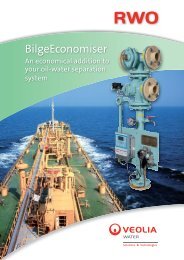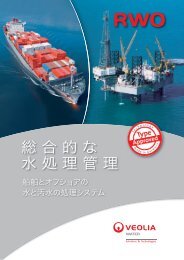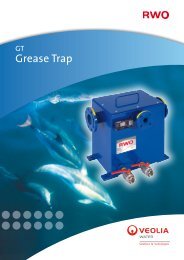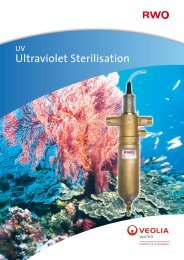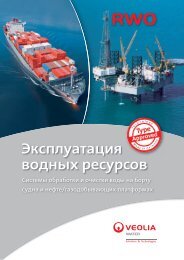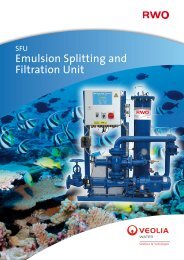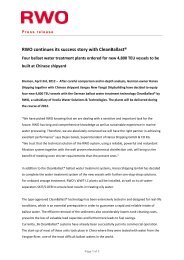the IHS Ballast Water Guide - RWO Marine Water Technology
the IHS Ballast Water Guide - RWO Marine Water Technology
the IHS Ballast Water Guide - RWO Marine Water Technology
You also want an ePaper? Increase the reach of your titles
YUMPU automatically turns print PDFs into web optimized ePapers that Google loves.
<strong>IHS</strong> Fairplay Solutions <strong>Guide</strong> to <strong>Ballast</strong> <strong>Water</strong> Treatment Systems Sponsored by<br />
removed and, at a certain pressure, backwash<br />
is discharged. <strong>Water</strong> is oxidised by means of an<br />
active substance, TG <strong>Ballast</strong>cleaner (developed<br />
by <strong>the</strong> Toagosei Group), in a dosing unit.<br />
Then, a Venturi-tube cavitation unit<br />
destroys plankton and bacteria before passing<br />
<strong>the</strong> water into <strong>the</strong> ship’s ballast tanks.<br />
During <strong>the</strong> discharge of ballast water,<br />
ballast pumps direct <strong>the</strong> water past ano<strong>the</strong>r<br />
dosing unit containing <strong>the</strong> active ingredient TG<br />
Environmentalguard, which reduces residual<br />
chlorine before <strong>the</strong> water reaches <strong>the</strong> se sea.<br />
MicroFade<br />
Kuraray<br />
In <strong>the</strong> MicroFade BWTS from Kuraray microorganisms<br />
are removed during <strong>the</strong> front-end<br />
process through high-precision filtration.<br />
Sufficient amounts are filtered out in <strong>the</strong> first<br />
stage to make it possible to effect a substantial<br />
reduction in <strong>the</strong> amount of active substances<br />
in <strong>the</strong> second-stage chemical treatment,<br />
during <strong>the</strong> post process.<br />
While ballasting is taking place, seawater<br />
is drawn into <strong>the</strong> system and passed through<br />
a filtration unit. The unwanted organisms<br />
are removed by <strong>the</strong> filters and discharged<br />
overboard, as filtered seawater proceeds<br />
through <strong>the</strong> system.<br />
Active substances are automatically<br />
injected into filtered ballast water by a<br />
chemical infusion unit. The disinfected<br />
seawater, infused with <strong>the</strong> active substance,<br />
passes to <strong>the</strong> ballast water tank.<br />
During <strong>the</strong> deballasting process <strong>the</strong><br />
levels of residual chloride concentration<br />
are measured and neutralisers are added<br />
automatically as required. A neutralising<br />
agent is infused when <strong>the</strong> chlorine level is<br />
too high. The treated ballast water is <strong>the</strong>n<br />
discharged overboard.<br />
An energy-saving operation is achieved<br />
2<br />
by means of Kuraray’s special filters with<br />
low-pressure requirements, which enables<br />
<strong>the</strong> MicroFade system to use existing power<br />
generators and ballast pumps. The compact<br />
design of <strong>the</strong> system’s primary components<br />
(filtration unit and chemical infusion unit)<br />
allows for space to be conserved.<br />
As it requires nei<strong>the</strong>r precise temperature<br />
control nor a large-sized tank, <strong>the</strong> system<br />
also helps reduce power consumption and<br />
conserve space. These savings derive from <strong>the</strong><br />
utilisation of solid chemical agents that can be<br />
stored at room temperature.<br />
En-<strong>Ballast</strong><br />
Kwang San 2 7<br />
The En-<strong>Ballast</strong> BWMS from Kwang San,<br />
based in Busan, South Korea, combines<br />
three modules for filtration, electrolytic<br />
disinfection and neutralisation.<br />
The filtration module consists of a<br />
50µm filter element with an automatic<br />
backflushing function, removing <strong>the</strong> larger<br />
particles and organisms from <strong>the</strong> seawater.<br />
It is fully automatic in terms of its operation<br />
and cleaning without interrupting <strong>the</strong><br />
filtration process. Backflushed water is<br />
returned into <strong>the</strong> sea in situ. This filter<br />
operates only during ballasting.<br />
The removal of larger organisms and<br />
particles by filtration reduces <strong>the</strong> amount of<br />
sodium hypochlorite required for disinfection.<br />
The electrolysis module generates sodium<br />
hypochlorite directly from seawater without<br />
<strong>the</strong> addition or mixing of o<strong>the</strong>r chemicals,<br />
before <strong>the</strong> water enters <strong>the</strong> ballast tanks.<br />
This module comes in various models with<br />
different capacities, ranging from <strong>the</strong> Enballast-500,<br />
which works at a rate of 500m 3 /h<br />
at a power of 35kW to <strong>the</strong> En-ballast-5000<br />
which processes at 5,000m 3 /h at 260kW.<br />
During <strong>the</strong> deballasting process, total<br />
22 © <strong>IHS</strong> Global Limited 2012<br />
012_037_CorrectedBW1204.indd 22 01/08/2012 15:33:26



